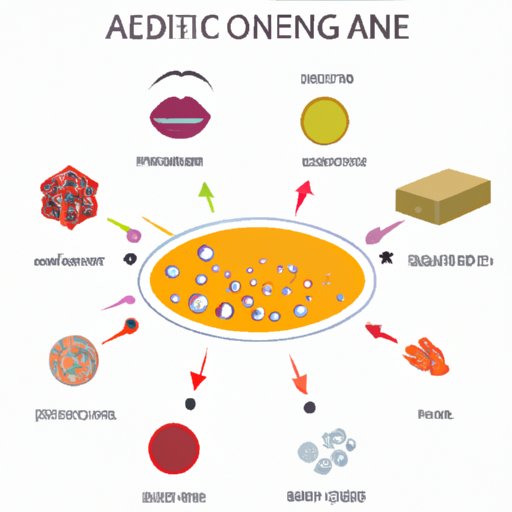Introduction
Acne is an incredibly common skin condition that can be caused by a variety of factors, including hormones, genetics, and lifestyle choices. It typically presents itself as red bumps, whiteheads, and blackheads on the face, chest, back, and neck. While there is no one-size-fits-all solution to clearing up acne, there are some steps you can take to reduce its appearance quickly and effectively.
Use a Topical Retinoid Treatment
A topical retinoid treatment is a type of medication that is applied directly to the skin. It contains vitamin A derivatives, which help to unclog pores, reduce inflammation, and prevent new breakouts from forming. Retinoid treatments come in a variety of forms, such as creams, gels, and lotions, and can be purchased over the counter or with a prescription from your doctor.
The benefits of using a retinoid treatment include: reducing inflammation, unclogging pores, preventing future breakouts, and improving skin texture. It is important to note that retinoid treatments can cause dryness and irritation, so it is best to start with a lower concentration and gradually increase as needed. Additionally, it is important to wear sunscreen when using a retinoid treatment, as it can make your skin more sensitive to the sun.

Follow a Consistent Skincare Routine
Following a consistent skincare routine is essential for keeping acne at bay. This includes cleansing, moisturizing, and exfoliating your skin regularly. Cleansing helps to remove excess oil and dirt that can clog pores and lead to breakouts. Moisturizing helps to keep skin hydrated and prevents dryness, which can aggravate existing acne. Exfoliating helps to remove dead skin cells, allowing other products to penetrate more deeply into the skin.
When choosing skincare products, it is important to look for ones that are specifically designed for acne-prone skin. These products should be non-comedogenic, meaning they won’t clog pores, and free of fragrances, dyes, and other potentially irritating ingredients. It is also important to avoid using harsh cleansers, scrubbing too hard, or picking at breakouts as these can further irritate the skin and slow down the healing process.
Eat Foods Rich in Antioxidants and Omega-3 Fatty Acids
Eating a diet rich in antioxidants and omega-3 fatty acids can help to reduce inflammation, which can contribute to acne. Antioxidants are found in fruits and vegetables, particularly those that are brightly colored, such as blueberries, spinach, and tomatoes. Omega-3 fatty acids are found in fatty fish, such as salmon and tuna, as well as flaxseeds, walnuts, and chia seeds. Eating a balanced diet that includes these foods can help to keep your skin healthy and reduce acne.

Avoid Using Harsh Skin Care Products
Harsh skin care products, such as astringents and toners, can strip away the skin’s natural oils and disrupt its protective barrier. This can lead to dryness, irritation, and further breakouts. Instead, opt for gentle, non-comedogenic products that are specifically designed for acne-prone skin. Cleansers, moisturizers, and exfoliators should all be free of fragrances, dyes, and other potentially irritating ingredients.
It is also important to limit your use of exfoliants and scrubs, as these can be too harsh for acne-prone skin. If you do choose to use an exfoliant, opt for a gentle one that contains natural ingredients, such as jojoba beads or fruit enzymes. Additionally, avoid using products that contain alcohol, as this can be drying and irritating.

Invest in a Good Acne Spot Treatment
Acne spot treatments are formulated to target individual pimples and blemishes. They often contain ingredients like benzoyl peroxide, which helps to kill bacteria and reduce inflammation. Other active ingredients include salicylic acid, which helps to unclog pores, and sulfur, which helps to reduce oil production. Spot treatments come in a variety of forms, such as creams, gels, and pads, and can be purchased over the counter or with a prescription from your doctor.
The benefits of using a spot treatment include: targeting individual blemishes, reducing inflammation, and unclogging pores. However, it is important to note that spot treatments can be drying and irritating, so it is best to start with a lower concentration and gradually increase as needed. Additionally, always read the instructions before use and avoid applying spot treatments to large areas of skin, as this can cause excessive dryness and irritation.
Conclusion
Clearing up acne quickly and effectively requires a combination of lifestyle changes and skincare products. Following these tips can help to reduce the appearance of acne in a short amount of time: using a topical retinoid treatment, following a consistent skincare routine, eating foods rich in antioxidants and omega-3 fatty acids, avoiding harsh skin care products, and investing in a good acne spot treatment. With a little bit of effort and patience, you can have clearer, healthier skin in no time.
Reminder of the Benefits of Following These Tips: reduced inflammation, unclogged pores, prevention of future breakouts, improved skin texture, targeted blemishes, and healthier, clearer skin.


